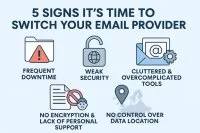
The main goal with any process related to emails is to ensure that you can get things done easily. When it comes to email forwarders, they provide a very specific function that is useful for many different situations.
This post is all about providing the basic steps needed in order to be able to create email forwards. How to use them, when to use them, and why to make use of them in the first place.
Email forwarders operate as intermediaries, intercepting emails sent to one address and automatically forwarding them to a designated destination. Unseen by the sender, this process ensures efficient message delivery to the intended recipient.
The process of configuring an email forwarder is straightforward and primarily depends on the email service utilized. Email providers typically offer intuitive steps to create forwarders through their settings. Although they outline general steps, users are advised to refer to their specific email service for precise instructions.
Email forwarding holds particular significance for businesses seeking streamlined communication channels. It facilitates the organization of various departmental email addresses, ensuring that each inquiry reaches the relevant employee or team responsible for addressing it promptly.
Embracing email forwarders yields several advantages:
Though valuable, email forwarders can encounter challenges, some of which include:
Complementing email forwarders are email address aliases. These aliases are virtual masks for primary email addresses that streamline email filtering and organization, leading all emails to the primary inbox while allowing users to distinguish the sources.
To safeguard communication and data privacy, prudent measures should be taken. Utilizing strong passwords, activating two-factor authentication, and regularly reviewing forwarding rules contribute to enhancing security.
There are some situations when you need to make use of this feature for as many addresses as needed. Managing multiple email addresses becomes more manageable through configuring email forwarders, ensuring systematic handling of incoming messages.
There are specific rules that you can set to email automation and this depends mainly on certain factors for the specific ese of an email address. Harnessing the capabilities of rules or filters in email clients enables the automation of email forwarding based on predefined criteria, thereby optimizing the process.
Once you manage to understand the problems that can arise with email forwarding, things become much easier. Awareness of common issues and their solutions empowers users to troubleshoot email forwarding complications effectively.
Email forwarders are truly invaluable tools for simplifying email management, irrespective of whether it pertains to personal correspondence or business operations. Once you get the hang of email forwarding and embrace the best practices, individuals and organizations can leverage this feature to optimize communication efficiency and ensure a seamless experience with their electronic correspondences.
![]() © 2022 - 2025 HostingBe.com Simple CMS versie 3.1.0
© 2022 - 2025 HostingBe.com Simple CMS versie 3.1.0